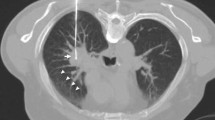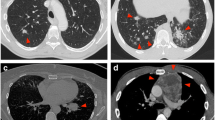Abstract
Objectives
To evaluate the diagnostic performance of lung biopsies performed immediately after radiofrequency ablation (RFA).
Methods
Twenty consecutive patients were treated with lung RFA. A biopsy was performed immediately after RFA, through the cannula used to insert the RFA probe to avoid hampering the RFA probe placement. Biopsies were analysed for diagnostic of malignancy and tumour morphological characteristics. Recurrence of RFA and procedure-related complications are reported.
Results
Mean tumour size was 17.3 mm (±6.2 mm). Ninety per cent (18/20) of biopsies were able to help diagnose malignancy. Cancer subtype and origin were determined in 70 % (14/20) of tumours, including 12 metastases and two primary lung cancers. During a median follow-up of 24 months, one tumour demonstrated local progression (5 %). The overall survival, lung disease-free survival and progression-free survival rates at 12 months were 100 %, 75 % and 65 %, respectively.
Adverse events of the procedure including RFA and biopsy were five pneumothoraces requiring chest tube placement (25 %), seven minor pneumothoraces (35 %) and one subsegmental intrapulmonary haemorrhage (5 %) not requiring any treatment.
Conclusions
A biopsy performed immediately after lung RFA allowed diagnosis of malignancy in 90 % of cases. This diagnosis is obtained without the need for additional puncture and does not hamper the accuracy of the initial RF probe placement.
Key Points
• Treatment and biopsy are feasible during the same procedure, avoiding multiple punctures.
• The best puncture path can be preserved to treat the lung tumour.
• Malignancy can be determined on a post-RFA biopsy in 90 % of cases.
• Cancer classification can be assessed in 70 % of cases after lung RFA.


Similar content being viewed by others
References
Rossi S, Di Stasi M, Buscarini E et al (1995) Percutaneous radiofrequency interstitial thermal ablation in the treatment of small hepatocellular carcinoma. Cancer J Sci Am 1:73–81
de Baere T (2011) Lung tumor radiofrequency ablation: where do we stand? Cardiovasc Intervent Radiol 34:241–251
Yasui K, Kanazawa S, Sano Y et al (2004) Thoracic tumors treated with CT-guided radiofrequency ablation: initial experience. Radiology 231:850–857
Dupuy DE (2011) Image-guided thermal ablation of lung malignancies. Radiology 260:633–655
Simon CJ, Dupuy DE, DiPetrillo TA et al (2007) Pulmonary radiofrequency ablation: long-term safety and efficacy in 153 patients. Radiology 243:268–275
de Baere T, Palussiere J, Auperin A et al (2006) Midterm local efficacy and survival after radiofrequency ablation of lung tumors with minimum follow-up of 1 year: prospective evaluation. Radiology 240:587–596
Manhire A, Charig M, Clelland C et al (2003) Guidelines for radiologically guided lung biopsy. Thorax 58:920–936
Hiraki T, Mimura H, Gobara H et al (2009) Two cases of needle-tract seeding after percutaneous radiofrequency ablation for lung cancer. J Vasc Interv Radiol 20:415–418
Yamakado K, Akeboshi M, Nakatsuka A et al (2005) Tumor seeding following lung radiofrequency ablation: a case report. Cardiovasc Intervent Radiol 28:530–532
Wang Q, Huang J, Ma K et al (2012) Evaluation of ghost cell survival in the area of radiofrequency ablation. PLoS One 7, e53158
Clasen S, Krober SM, Kosan B et al (2008) Pathomorphologic evaluation of pulmonary radiofrequency ablation: proof of cell death is characterized by DNA fragmentation and apoptotic bodies. Cancer 113:3121–3129
Sacks D, McClenny TE, Cardella JF, Lewis CA (2003) Society of Interventional Radiology clinical practice guidelines. J Vasc Interv Radiol 14:S199–S202
Yeow KM, Su IH, Pan KT et al (2004) Risk factors of pneumothorax and bleeding: multivariate analysis of 660 CT-guided coaxial cutting needle lung biopsies. Chest 126:748–754
Ko JP, Shepard JO, Drucker EA et al (2001) Factors influencing pneumothorax rate at lung biopsy: are dwell time and angle of pleural puncture contributing factors? Radiology 218:491–496
Khan MF, Straub R, Moghaddam SR et al (2008) Variables affecting the risk of pneumothorax and intrapulmonal hemorrhage in CT-guided transthoracic biopsy. Eur Radiol 18:1356–1363
Schneider T, Puderbach M, Kunz J et al (2012) Simultaneous computed tomography-guided biopsy and radiofrequency ablation of solitary pulmonary malignancy in high-risk patients. Respiration 84:501–508
Montaudon M, Latrabe V, Pariente A, Corneloup O, Begueret H, Laurent F (2004) Factors influencing accuracy of CT-guided percutaneous biopsies of pulmonary lesions. Eur Radiol 14:1234–1240
Lucidarme O, Howarth N, Finet JF, Grenier PA (1998) Intrapulmonary lesions: percutaneous automated biopsy with a detachable, 18-gauge, coaxial cutting needle. Radiology 207:759–765
Gupta S, Wallace MJ, Cardella JF, Kundu S, Miller DL, Rose SC (2010) Quality improvement guidelines for percutaneous needle biopsy. J Vasc Interv Radiol 21:969–975
Lencioni R, Crocetti L, Cioni R et al (2008) Response to radiofrequency ablation of pulmonary tumours: a prospective, intention-to-treat, multicentre clinical trial (the RAPTURE study). Lancet Oncol 9:621–628
Sofocleous CT, Garg S, Petrovic LM et al (2012) Ki-67 is a prognostic biomarker of survival after radiofrequency ablation of liver malignancies. Ann Surg Oncol 19:4262–4269
Yoon HJ, Lee HY, Lee KS et al (2012) Repeat biopsy for mutational analysis of non-small cell lung cancers resistant to previous chemotherapy: adequacy and complications. Radiology 265:939–948
Arnedos M, Vielh P, Soria JC, Andre F (2013) The genetic complexity of common cancers and the promise of personalized medicine: is there any hope? J Pathol. doi:10.1002/path.4276
Chu KF, Dupuy DE (2014) Thermal ablation of tumours: biological mechanisms and advances in therapy. Nat Rev Cancer 14:199–208
Hamamoto S, Okuma T, Yamamoto A et al (2013) Radiofrequency ablation and immunostimulant OK-432: combination therapy enhances systemic antitumor immunity for treatment of VX2 lung tumors in rabbits. Radiology 267:405–413
Kageyama K, Yamamoto A, Okuma T et al (2013) Radiofrequency ablation of liver tumors in combination with local OK-432 injection prolongs survival and suppresses distant tumor growth in the rabbit model with intra- and extrahepatic VX2 tumors. Cardiovasc Intervent Radiol 36:1383–1392
Acknowledgments
The authors would like to thank Lorna Saint-Ange for editing. The scientific guarantor of this publication is Dr Lambros Tselikas. The authors of this manuscript declare no relationships with any companies whose products or services may be related to the subject matter of the article.
The authors state that this work has not received any funding. One of the authors has significant statistical expertise and no complex statistical methods were necessary for this paper.
Institutional review board approval was obtained. Written informed consent was waived by the institutional review board. Methodology: retrospective, diagnostic or prognostic study, performed at one institution.
Author information
Authors and Affiliations
Corresponding author
Rights and permissions
About this article
Cite this article
Tselikas, L., de Baere, T., Deschamps, F. et al. Diagnostic yield of a biopsy performed immediately after lung radiofrequency ablation. Eur Radiol 27, 1211–1217 (2017). https://doi.org/10.1007/s00330-016-4447-7
Received:
Revised:
Accepted:
Published:
Issue Date:
DOI: https://doi.org/10.1007/s00330-016-4447-7




